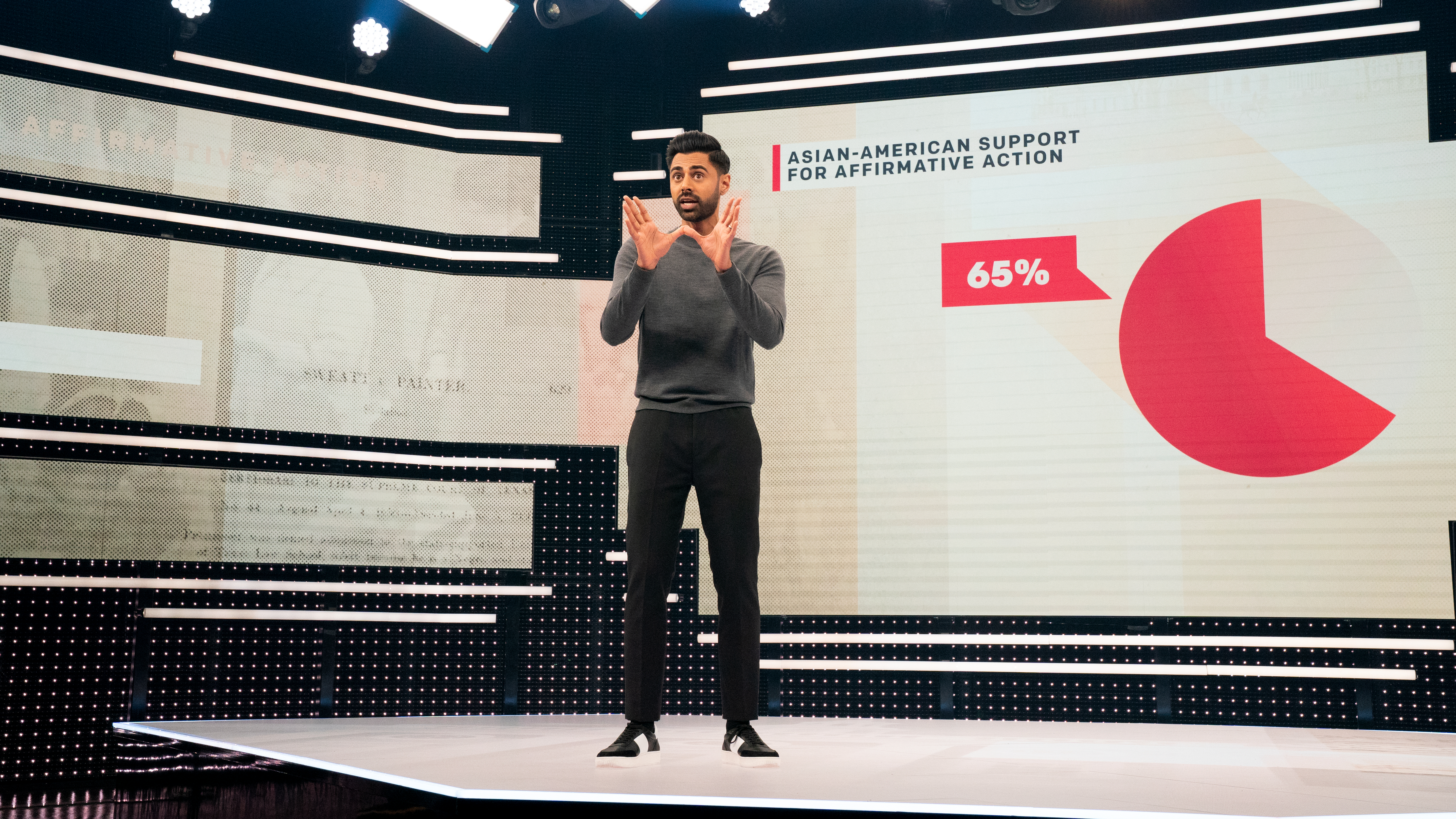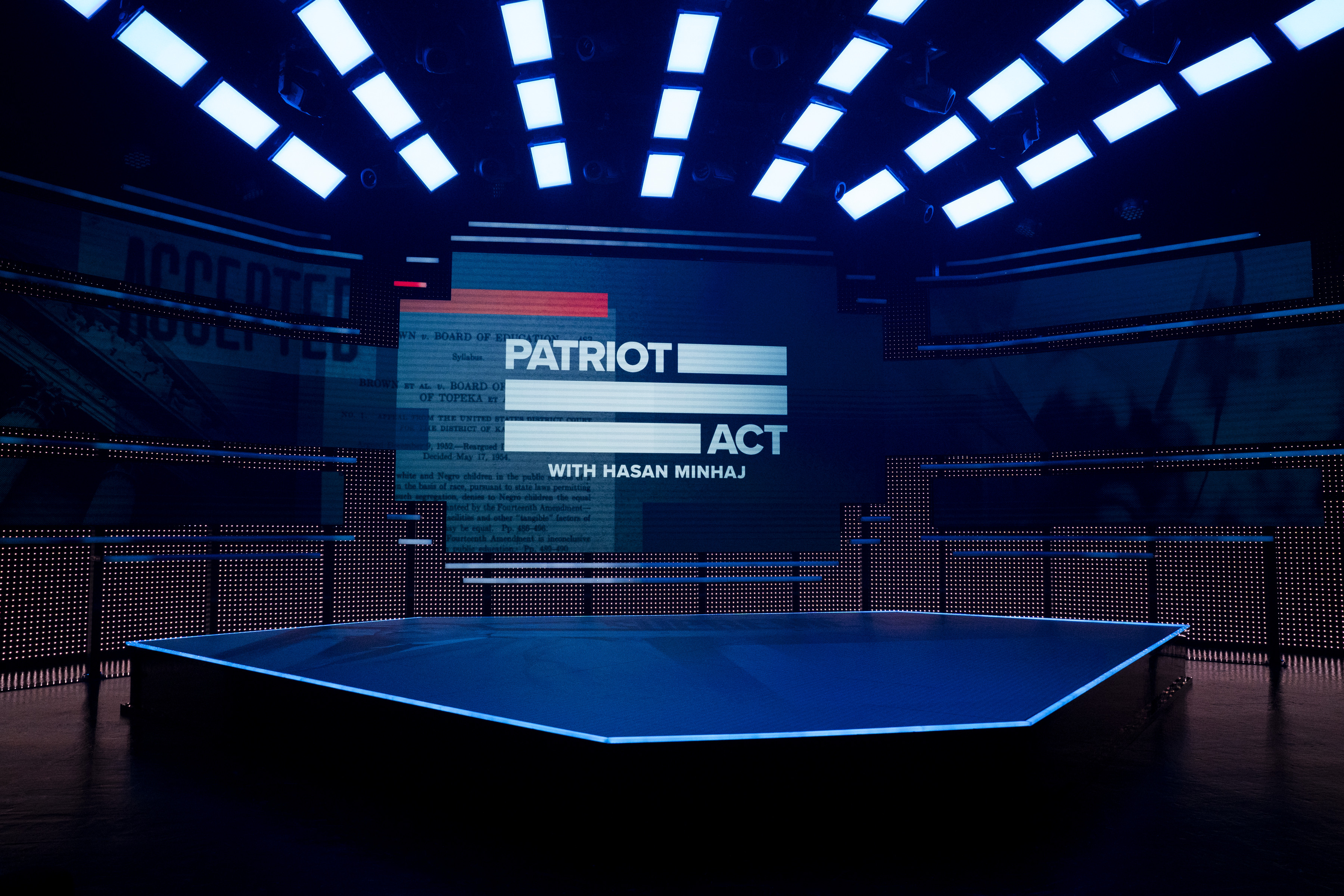The Netflix original series Patriot Act with Hasan Minhaj is a media-rich, fast-changing production that relies on dynamic content to support each episode’s theme. To realize the media-heavy set design for broadcast, production designer Marc Janowitz and producers Art & Industry brought in 5TEN, an LED display design engineering team to deliver the show’s video display systems.
Minhaj—a Peabody Award-winning comedian for his Netflix special Homecoming King and former correspondent for Comedy Central’s The Daily Show—headlines the original series, which explores modern culture, politics, and global news through his irreverent mix of comedy and storytelling. Each weekly episode uses infographics, data, and video content to enhance the topics he covers.
[Sound Storytelling: Netflix's Russian Doll]
Janowitz, best known for his concert production designs for acts including My Morning Jacket and Blue Man Group, also designed Minhaj’s Homecoming King special; he was brought back to be the production and lighting designer for the weekly Patriot Act series. His design uses unique shapes and configurations of LED displays to surround Minhaj in an immersive environment, so careful consideration of display products was key to 5TEN’s level of involvement.

“At 5TEN, our approach is to work with the designer and client to understand the overall design intent and provide the strongest possible product solution to meet their needs,” said Ben Price, design and engineering director at 5TEN. “We advised on a range of LED video display products that would be most suited to each component of the design. The way Hasan interacts with the screens and the cameras in a rather close proximity gave us some key challenges to focus on.”
Moiré is always an issue that must be addressed when using LED screens on broadcast projects. Price explained, “Moiré has always been a big issue with LED displays and cameras, so it was important to know how to shoot it to compensate; however, there are also specific features of LED displays that can help mitigate this issue as well. To help determine the best solution for this set design, we worked with the producers, the production team, and the executives from Netflix by conducting camera tests with various resolutions of LED products at our studio.” Looking back on the project, Janowitz feels that the testing at 5TEN was “invaluable and well worth the time to find the right product and way to shoot it to minimize this issue. The 5TEN team really helped us understand the available options.”
5TEN was initially brought in to help with the creation of a specification for the video display system. Over time, their scope of work expanded, launching them into a much different role. During the design and development process, it became clear that 5TEN was well suited to help navigate the product landscape and support the necessary custom choices. “The added benefits of having brand-new gear, the capital improvement value for the TV studio, and the availability of the product in a short turnaround time made it all a logical decision,” explains Norah Beijer, 5TEN’s commercial director. “Within six weeks, the displays arrived at the TV studio.”
[The Growing Accessibility of Large-Scale Video Walls]
The aesthetic of the video walls in Janowitz’s design was a visual departure from the traditional over-the-shoulder rectangle of video. “We quickly dispelled with that approach,” said Janowitz. “There was a need to have some more recognizable kind of continuous video playing in order to tell certain stories. But there was also a desire to have it be much more environmental—much more immersive, in a way.”
In the design process, Janowitz wanted to avoid placing the displays in specific locations. He explained, “The less specific we make the location, the more flexible, and the more open we are creatively to how we can use screen content to really place us in every single week’s episode. As a result, it offers limitless possibilities.”
The main display is a configuration of an ultra-high-resolution 1.9 mm LED video product that also consists of 22-degree concave angled banner displays—with the same 1.9 mm product connected to the main display and extending out and wrapping the set. The floor of the set features a diamond-shaped LED floor composed of a 4.7 mm LED product covered with triangular-shaped acrylic diffusers. There’s a 25 mm LED screen behind the main display, along with 10 mm diffused LED strips in the backdrop and 14 mm diffused LED strips for the floor edge.
With the show being so media-heavy, fast-changing, and dynamic with regard to content, “the combination of the disguise 4x4 media server and Barco S3 image processor provided the optimal solution to deliver the content to the display,” said David Imlau, 5TEN’s technical director. All control and data transfer infrastructure—switchers and routers, LED control processors, monitors, and programming computers—for the video elements were also provided and installed by 5TEN.
The installation at All Mobile Video’s soundstages in New York City was completed in two weeks, plus a week of programming, tweaking, and fine-tuning. During the installation of the LED product and video distribution systems, 5TEN’s Price and Imlau were on site to make sure the integration in the TV studio went smoothly. “5TEN was able to integrate, communicate, and collaborate with all the studio technicians and engineers,” said Janowitz. “The install was a pretty complicated array between what was going to be in the studio and in the control room. They were there all the way through the test episodes. They were here constantly, not just tweaking it until it works, but they really understood that this was a full-fledged, all-in commitment.”
